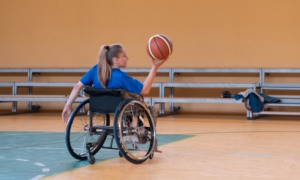For years now, I and other disability advocates have been fighting to end the use of electroshock treatment on youth with behavioral, emotional and sometimes psychiatric challenges at the Judge Rotenberg Center in Canton, Mass., which is said to be the only educational institution of its kind in the nation.
Though a federal judge in July 2021 overturned a 2020 Food and Drug Administration ban against what’s called a graduated electronic decelerator, siding with parents who supported use of that treatment, our fight against electroshock continues.
The FDA had outlawed the Rotenberg Center’s use of electroshock, the subject of an April 2021 report by NBC News, saying “the devices presented a substantial and unreasonable risk to self-injurious and aggressive patients … ”
It is a pity that the FDA’s short-lived ban was reversed by a judge who may not know or be concerned about the full, human effect of this ruling.
 Here’s a back story: In fall of 2002, a Rotenberg Center employee dialed Cheryl Collins, of Brooklyn, N.Y., to explain that Collins’ son Andre, a Rotenberg student, had been shocked 31 times as punishment for tensing up his body, which the school deemed as “uncontrolled behavior.” Although Collins had agreed that Rottenberg could make Andre wear a backpack with a remotely triggered electroshock device inside of it, she was stunned by the number of times the shock was administered. Employees did that, repeatedly, by touching a button that they kept within easy reach.
Here’s a back story: In fall of 2002, a Rotenberg Center employee dialed Cheryl Collins, of Brooklyn, N.Y., to explain that Collins’ son Andre, a Rotenberg student, had been shocked 31 times as punishment for tensing up his body, which the school deemed as “uncontrolled behavior.” Although Collins had agreed that Rottenberg could make Andre wear a backpack with a remotely triggered electroshock device inside of it, she was stunned by the number of times the shock was administered. Employees did that, repeatedly, by touching a button that they kept within easy reach.
Opened in 1971, Rotenberg enrolls five-year-olds through adults. The center’s website touts Rotenberg as providing “very effective education and treatment to both emotionally disturbed students with conduct, behavior, emotional, and/or psychiatric problems, as well as those with intellectual disabilities or on the autism spectrum.”
Those students do need special education and care. But students at Rotenberg could be shocked with electricity measuring up to 41 milliamps from the electric decelerator, according to this 2008 article in Boston Magazine. Even at that level, according to the article, that was less electricity than what flows from a stun gun.
But that doesn’t mean that the device didn’t cause pain to or frighten those who were being shocked.
“I would ask God to make my heart stop because I didn’t want to live when that was happening to me.”
That’s what Rotenberg survivor Jennifer Msumba said in a 2014 interview with CBS News. She also said that sometimes the devices would misfire, going off at times when staff didn’t intend to shock students or shocking a student other than one staffers hadn’t intended to shock.
“That happened to me in double digits, where it would go off by itself, maybe, if it got wet. One time I got caught in the rain. Other times, if they give a [shock] to someone else nearby and that device is too similar to yours, it can set yours off,” Msumbai said.
It’s not just Rotenberg students who have publicly spoken out against electroshock therapy. A former employee, Gregory Miller, has also said that he witnessed students being shocked for behaviors that he felt were not worthy of punishment. “… [S]tudent behavior plans … dictated we shock certain students for even the most minor of behavioral issues, like closing their eyes for 15 seconds while sitting at a desk, pulling a part of a loose piece of paper, tearing an empty used paper cup, or for standing up and raising a hand to ask to go to the bathroom,” said Miller, whose testimony was included in a 2006 New York State Department of Education report. That report noted that the Rotenberg center also students “without a clear history of self-injurious behaviors” also were “being subjected to electroshock therapy.”
It is utterly terrifying that the behaviors for which students were being punished are behaviors that, in a public school setting, likely wouldn‘t even get students with these kinds of disabilities sent to the principal’s office for a reprimand. That judgment of those pushing that button should be called into question.
It’s hard to defend the idea that, in these cases, the punishment fits the crime. Shocking students for sport, so to speak, is a wholly inappropriate practice for an educational institution. A study on electroshock’s long-term effects on students with self-injurious behaviors, published in May 2021 in the British Medical Journal, concluded that students reverted back to their old behaviors as soon as the treatments stopped. The study also found that electroshock’s effectiveness waned over time, requiring stronger shocks to get similar results in altering behavior.
Abuse against people with disabilities in institutionalized settings is nothing new, whether it be through forced treatment, involuntary medical experimentation, or isolation.
Even if the shocks have been successful in modifying a student’s behavior, I would implore the school to find an alternative method of changing students’ behavior, one that doesn’t inflict psychological or potential bodily harm.
Disability rights advocate and writer Molly Wiesman is the layout editor and a contributor to “Imagine the World as One: A Disability Lifestyle Magazine.” She has cerebral palsy.






























